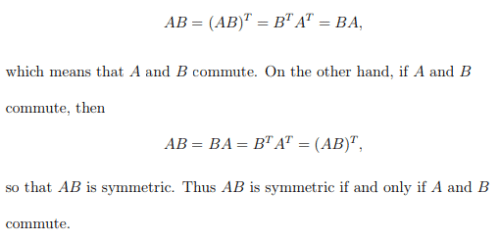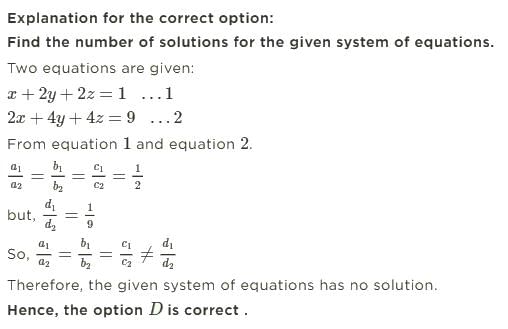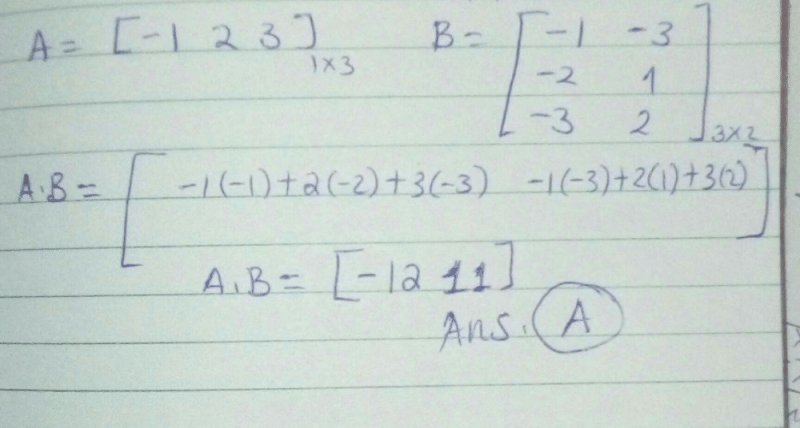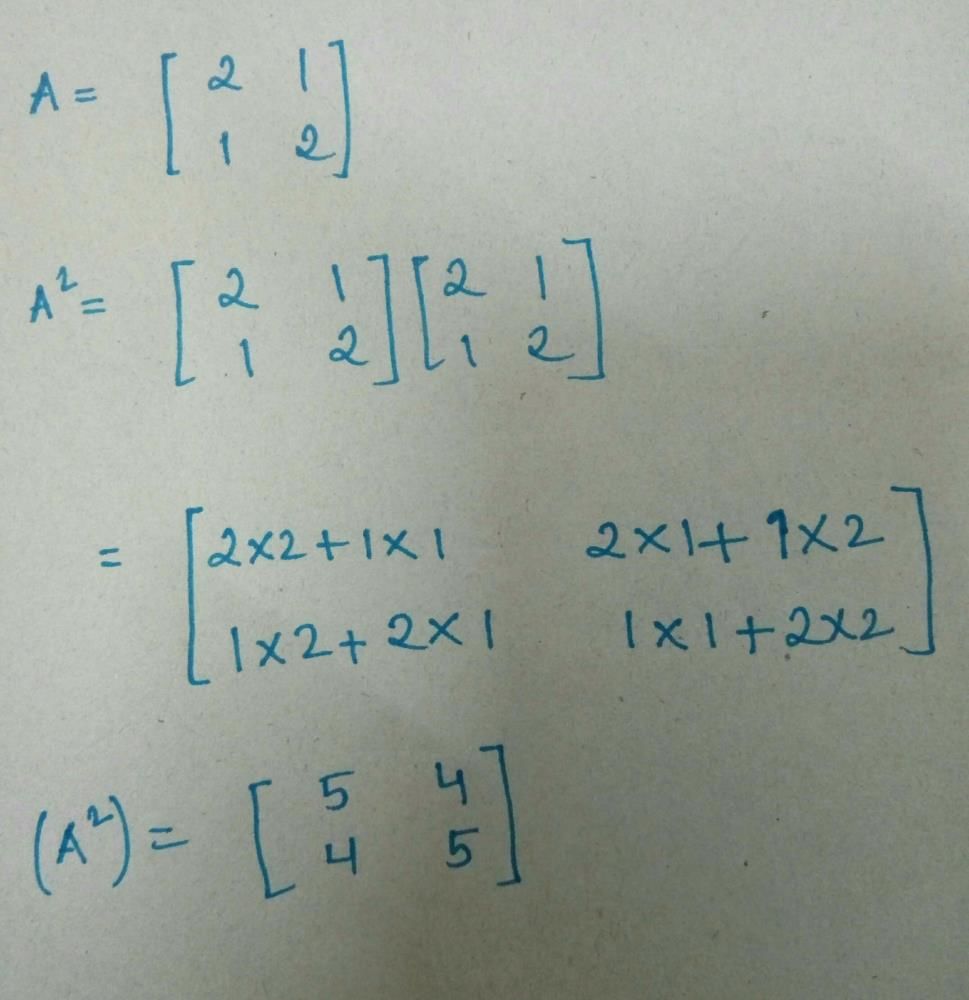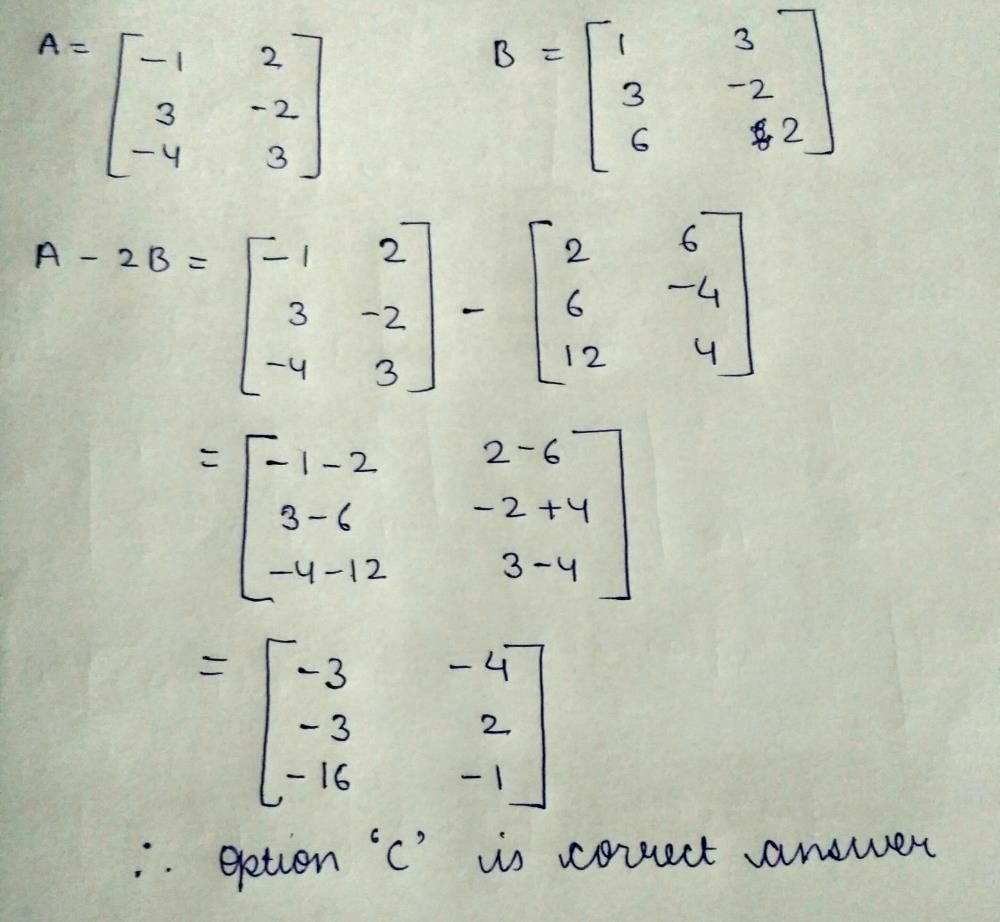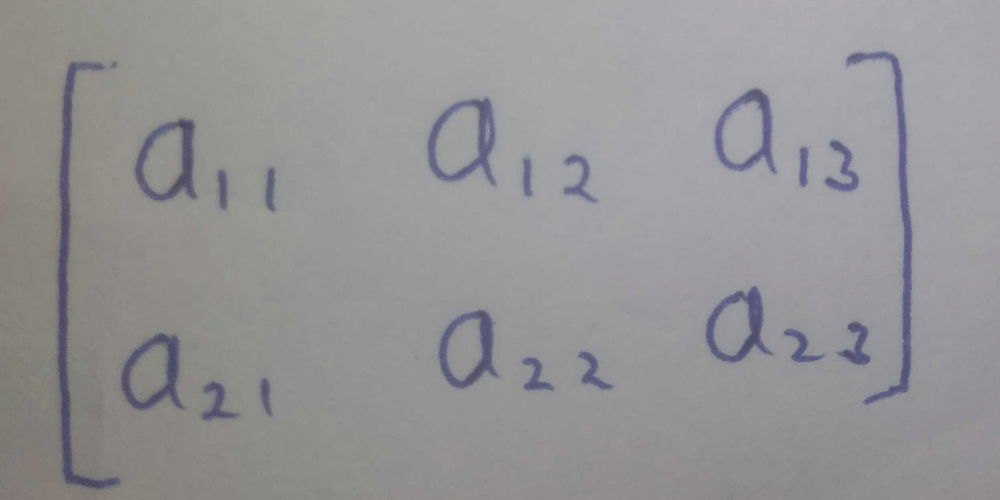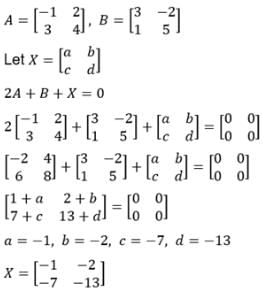All Exams >
JEE >
Mathematics CUET UG Mock Test Series 2026 >
All Questions
All questions of Chapter 3 - Matrices for JEE Exam
 the value of a22 is
the value of a22 is
- a)0
- b)-2
- c)2
- d)None
Correct answer is option 'C'. Can you explain this answer?
a)
0
b)
-2
c)
2
d)
None

|
Amrit Raj answered |
I=2,j=2
modulus of 2-6=4
4/2=2
hence the correct ans is C :2

- a)

- b)

- c)

- d)

Correct answer is option 'D'. Can you explain this answer?
a)
b)
c)
d)

|
Sushil Kumar answered |
P(n) : An = {(1+2n, -4n), (n,(1 - 2n))}
= P(k + 1) = {(1+2(k+1), -4(k+1)), (k+1, (1 - 2(k+1)}
= {(1+2k+2, -4k-4) (k+1, 1-2k-2)}
= {(2k+3, -4k-4), (k+1, -2k-1)}
= P(k + 1) = {(1+2(k+1), -4(k+1)), (k+1, (1 - 2(k+1)}
= {(1+2k+2, -4k-4) (k+1, 1-2k-2)}
= {(2k+3, -4k-4), (k+1, -2k-1)}
 Then the value of x is ____
Then the value of x is ____- a)6
- b)3
- c)2
- d)0
Correct answer is option 'B'. Can you explain this answer?
a)
6
b)
3
c)
2
d)
0
|
|
Geetika Shah answered |

= x+10 = 3x+4
= x = 3
 is example of
is example of- a)an identity matrix
- b)a zero matrix.
- c)a Scalar m
- d)diagonal matrix.
Correct answer is option 'D'. Can you explain this answer?
a)
an identity matrix
b)
a zero matrix.
c)
a Scalar m
d)
diagonal matrix.

|
Divey Sethi answered |
A matrix having non-zero elements only in the diagonal running from the upper left to the lower right.
The given matrix is a diagonal matrix.
If  and
and  , then AB=?
, then AB=?- a)[7]
- b)[1 - 12]
- c)

- d)[18]
Correct answer is option 'A'. Can you explain this answer?
If  and
and  , then AB=?
, then AB=?
a)
[7]
b)
[1 - 12]
c)
d)
[18]
|
|
Ritu Singh answered |
A = [2, 3, 4]
 Therefore AXB = {(2*1) + (3*(-1)) + (4*2)}
Therefore AXB = {(2*1) + (3*(-1)) + (4*2)}
AXB = {2 + (-3) + 8}
AXB = 7
 Therefore AXB = {(2*1) + (3*(-1)) + (4*2)}
Therefore AXB = {(2*1) + (3*(-1)) + (4*2)}AXB = {2 + (-3) + 8}
AXB = 7
If A, B are symmetric matrices of same order then the matrix AB-BA is a- a)Skew-symmetric matrix
- b)Skew-Harmitian matrix
- c)Symmetric matrix
- d)Harmitian matrix
Correct answer is option 'A'. Can you explain this answer?
If A, B are symmetric matrices of same order then the matrix AB-BA is a
a)
Skew-symmetric matrix
b)
Skew-Harmitian matrix
c)
Symmetric matrix
d)
Harmitian matrix

|
Sushil Kumar answered |
A and B are symmetric matrices, therefore, we have:
A′=A and B′=B..........(i)
Consider
(AB−BA)′=(AB)′ − (BA)′,[∵(A−B)′=A′B′]
=B′A′− A′B',[∵(AB)′= B′A]
=BA−AB [by (i) ]
=−(AB−BA)
∴(AB−BA) ′=−(AB−BA)
Thus, (AB−BA) is a skew-symmetric matrix.
A′=A and B′=B..........(i)
Consider
(AB−BA)′=(AB)′ − (BA)′,[∵(A−B)′=A′B′]
=B′A′− A′B',[∵(AB)′= B′A]
=BA−AB [by (i) ]
=−(AB−BA)
∴(AB−BA) ′=−(AB−BA)
Thus, (AB−BA) is a skew-symmetric matrix.
The number of all possible matrices of order 3×3 with each entry 0 if 1 is- a)81
- b)512
- c)18
- d)none of these
Correct answer is option 'B'. Can you explain this answer?
The number of all possible matrices of order 3×3 with each entry 0 if 1 is
a)
81
b)
512
c)
18
d)
none of these
|
|
Harsh Majumdar answered |
To find the number of all possible matrices of order 3, we need to consider the number of choices for each entry in the matrix.
In a matrix of order 3, there are 9 entries. Each entry can be chosen from any number in the set {0, 1, 2, ..., 9} since there are no restrictions mentioned. Therefore, there are 10 choices for each entry.
Since each entry can be chosen independently, we can use the multiplication principle to find the total number of matrices. This principle states that if there are n choices for one event and m choices for another event, then there are n * m choices for both events together.
Applying this principle to our matrix, we have 10 choices for each of the 9 entries. Therefore, the total number of possible matrices of order 3 is 10^9.
Hence, the number of all possible matrices of order 3 is 10^9.
In a matrix of order 3, there are 9 entries. Each entry can be chosen from any number in the set {0, 1, 2, ..., 9} since there are no restrictions mentioned. Therefore, there are 10 choices for each entry.
Since each entry can be chosen independently, we can use the multiplication principle to find the total number of matrices. This principle states that if there are n choices for one event and m choices for another event, then there are n * m choices for both events together.
Applying this principle to our matrix, we have 10 choices for each of the 9 entries. Therefore, the total number of possible matrices of order 3 is 10^9.
Hence, the number of all possible matrices of order 3 is 10^9.
If  , then
, then  is equal to
is equal to - a)

- b)

- c)

- d)

Correct answer is option 'D'. Can you explain this answer?
If  , then
, then  is equal to
is equal to
a)
b)
c)
d)
|
|
Geetika Shah answered |
A’ = {(1,-1,5) (0,0,2)} B = {(-2,0) (0,2) (3,4)}
B’ = {(-2,0,3) (0,2,4)}
2B’ = 2{(-2,0,3) (0,2,4)}
2B’ = {(-4,0,6) (0,4,8)}
(A’ - 2B’) = {(1,-1,5) (0,0,2)} - {(-4,0,6) (0,4,8)}
= {(5,-1,-1) (0,-4,-6)}
(A’ - 2B’)’ = {(5,0) (-1,-4) (-1,-6)}
B’ = {(-2,0,3) (0,2,4)}
2B’ = 2{(-2,0,3) (0,2,4)}
2B’ = {(-4,0,6) (0,4,8)}
(A’ - 2B’) = {(1,-1,5) (0,0,2)} - {(-4,0,6) (0,4,8)}
= {(5,-1,-1) (0,-4,-6)}
(A’ - 2B’)’ = {(5,0) (-1,-4) (-1,-6)}
The value of λ, for which system of equations. x + y + z = 1, x + 2y + 2z = 3, x + 2y + λz = 4, have no solution is
- a)1
- b)2
- c)0
- d)3
Correct answer is option 'B'. Can you explain this answer?
The value of λ, for which system of equations. x + y + z = 1, x + 2y + 2z = 3, x + 2y + λz = 4, have no solution is
a)
1
b)
2
c)
0
d)
3
|
|
Kiran Sengupta answered |
This question is unclear as there is no context or information provided. Please provide more details for me to give a relevant answer.
Consider the following information regarding the number of men and women workers in three BPOs I, II and III What does the entry in the second row and first column represent if the information is represented as a 3 x 2 matrix?
What does the entry in the second row and first column represent if the information is represented as a 3 x 2 matrix?- a)The number of Men in BPO II
- b)The number of Women in BPO II
- c)The number of Women in BPO I
- d)The number of Men in BPO I
Correct answer is 'A'. Can you explain this answer?
Consider the following information regarding the number of men and women workers in three BPOs I, II and III
What does the entry in the second row and first column represent if the information is represented as a 3 x 2 matrix?
a)
The number of Men in BPO II
b)
The number of Women in BPO II
c)
The number of Women in BPO I
d)
The number of Men in BPO I
|
|
Sanjeevini Angadi answered |
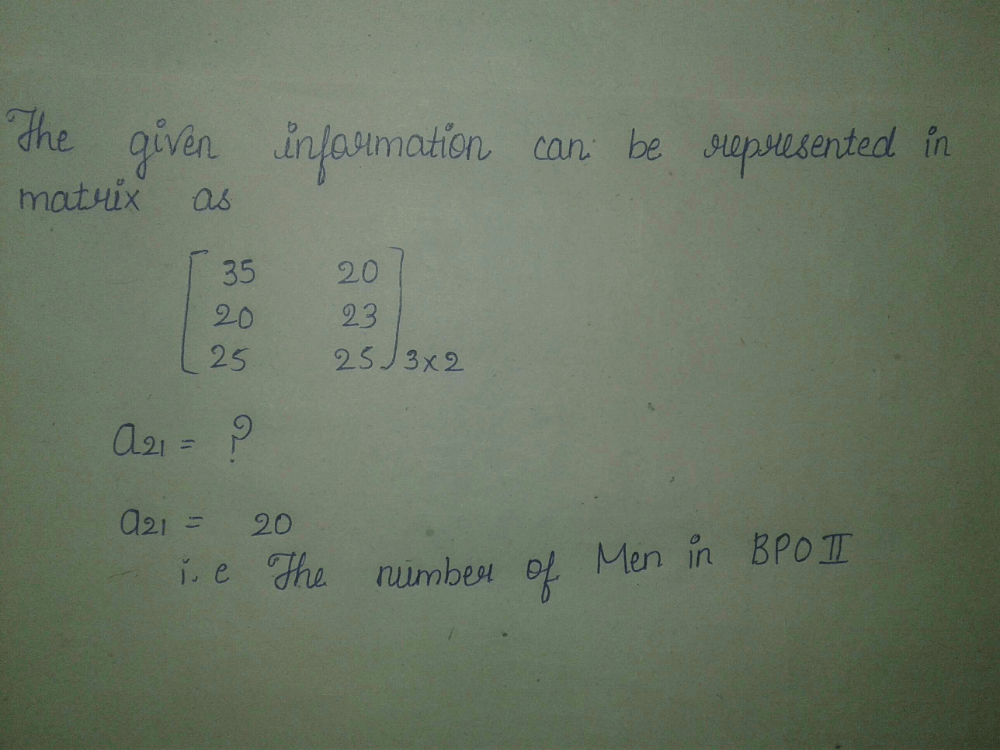
For a skew symmetric even ordered matrix A of integers, which of the following will not hold true:
- a)det(A) = 9
- b)det(A) = 81
- c)det(A) = 7
- d)det(A) = 4
Correct answer is option 'C'. Can you explain this answer?
For a skew symmetric even ordered matrix A of integers, which of the following will not hold true:
a)
det(A) = 9
b)
det(A) = 81
c)
det(A) = 7
d)
det(A) = 4
|
|
Aniket Dasgupta answered |
Skew Symmetric Even Ordered Matrix and Determinant
Skew Symmetric Matrix:
A skew symmetric matrix is a square matrix whose transpose is equal to its negative. In other words, if A is a skew symmetric matrix, then A^T = -A.
Example:
[0 -3 4]
[3 0 -5]
[-4 5 0]
This is a 3x3 skew symmetric matrix because A^T = -A.
Even Ordered Matrix:
An even ordered matrix is a square matrix whose order is even. In other words, if A is an even ordered matrix, then the order of A is 2n, where n is a positive integer.
Example:
[2 1 5 3]
[4 6 8 2]
[9 7 1 5]
[3 4 2 6]
This is a 4x4 even ordered matrix because the order of A is 2n=4.
Determinant of a Skew Symmetric Even Ordered Matrix:
The determinant of a skew symmetric even ordered matrix is always equal to zero. This is because the determinant of a skew symmetric matrix of odd order is always equal to zero and the determinant of any even ordered matrix can be expressed as a sum of permutations of the determinants of its n x n submatrices. Since the submatrices of a skew symmetric matrix are also skew symmetric, their determinants are equal to zero. Therefore, the determinant of a skew symmetric even ordered matrix is also equal to zero.
Solution:
a) det(A) = 9
Since the determinant of a skew symmetric even ordered matrix is always equal to zero, this statement is false. Therefore, option 'a' is not true.
b) det(A) = 81
Since the determinant of a skew symmetric even ordered matrix is always equal to zero, this statement is false. Therefore, option 'b' is not true.
c) det(A) = 7
This statement is false because the determinant of a skew symmetric even ordered matrix is always equal to zero.
d) det(A) = 4
Since the determinant of a skew symmetric even ordered matrix is always equal to zero, this statement is false. Therefore, option 'd' is not true.
Therefore, the correct answer is option 'c'.
Skew Symmetric Matrix:
A skew symmetric matrix is a square matrix whose transpose is equal to its negative. In other words, if A is a skew symmetric matrix, then A^T = -A.
Example:
[0 -3 4]
[3 0 -5]
[-4 5 0]
This is a 3x3 skew symmetric matrix because A^T = -A.
Even Ordered Matrix:
An even ordered matrix is a square matrix whose order is even. In other words, if A is an even ordered matrix, then the order of A is 2n, where n is a positive integer.
Example:
[2 1 5 3]
[4 6 8 2]
[9 7 1 5]
[3 4 2 6]
This is a 4x4 even ordered matrix because the order of A is 2n=4.
Determinant of a Skew Symmetric Even Ordered Matrix:
The determinant of a skew symmetric even ordered matrix is always equal to zero. This is because the determinant of a skew symmetric matrix of odd order is always equal to zero and the determinant of any even ordered matrix can be expressed as a sum of permutations of the determinants of its n x n submatrices. Since the submatrices of a skew symmetric matrix are also skew symmetric, their determinants are equal to zero. Therefore, the determinant of a skew symmetric even ordered matrix is also equal to zero.
Solution:
a) det(A) = 9
Since the determinant of a skew symmetric even ordered matrix is always equal to zero, this statement is false. Therefore, option 'a' is not true.
b) det(A) = 81
Since the determinant of a skew symmetric even ordered matrix is always equal to zero, this statement is false. Therefore, option 'b' is not true.
c) det(A) = 7
This statement is false because the determinant of a skew symmetric even ordered matrix is always equal to zero.
d) det(A) = 4
Since the determinant of a skew symmetric even ordered matrix is always equal to zero, this statement is false. Therefore, option 'd' is not true.
Therefore, the correct answer is option 'c'.
The product of two matrics 
- a)

- b)

- c)

- d)

Correct answer is option 'B'. Can you explain this answer?
The product of two matrics 
a)
b)
c)
d)

|
Sushil Kumar answered |
{(1*0, 2*2, 0*x) (2*0, 0*2, 1*x) (1*0, 0*2, 2*x)}
= {4, x, 2x}
= {4, x, 2x}
If  and
and  then
then  is equal to
is equal to- a)

- b)

- c)

- d)

Correct answer is option 'B'. Can you explain this answer?
If  and
and  then
then  is equal to
is equal to
a)
b)
c)
d)

|
Sakshi Dagar answered |
Hey multiply A by B . Then you easily get answer
 , then (AB)` is equal to
, then (AB)` is equal to- a)

- b)

- c)

- d)

Correct answer is option 'A'. Can you explain this answer?
a)
b)
c)
d)
|
|
Vikas Kapoor answered |
A ={(1,2) (4,3)} B = {(3,2) (-1,1)}
AB= {[(1*3)+(2*(-1)) (1*2)+(2*1)] [(4*3)+(3 *(-1)) (4*2)+(3*1)]}
= {(1,4) (9,11)}
AB= {[(1*3)+(2*(-1)) (1*2)+(2*1)] [(4*3)+(3 *(-1)) (4*2)+(3*1)]}
= {(1,4) (9,11)}
If A and B are two matrices conformable to multiplication such that their product AB = O(Zero matrix). Then which of the following can be true
- a)A and B are both null matrices
- b)Either of A is or B is a null matrix
- c)Either of them may be a zero matrix
- d)It is Not necessary that A = 0 or B = 0
Correct answer is option 'D'. Can you explain this answer?
If A and B are two matrices conformable to multiplication such that their product AB = O(Zero matrix). Then which of the following can be true
a)
A and B are both null matrices
b)
Either of A is or B is a null matrix
c)
Either of them may be a zero matrix
d)
It is Not necessary that A = 0 or B = 0
|
|
Gaurav Kumar answered |
AB = 0 does not necessarily imply that either A or B is a null matrix
- Both matrices need not be null matrices.
- Both matrices need not be null matrices.
For a skew symmetric odd ordered matrix A of integers, which of the following will hold true:- a)det(A) = 9
- b)det(A) = 81
- c)det(A) = 0
- d)et(A) = 4
Correct answer is option 'C'. Can you explain this answer?
For a skew symmetric odd ordered matrix A of integers, which of the following will hold true:
a)
det(A) = 9
b)
det(A) = 81
c)
det(A) = 0
d)
et(A) = 4
|
|
Raghav Bansal answered |
Determinant of a skew symmetric odd ordered matrix A is always 0 .
If A and B are square matrices of the same order, then(A+B)2 = A2+2AB+B2 implies- a)AB + BA = O
- b)AB = O
- c)AB = BA
- d)none of these.
Correct answer is 'A'. Can you explain this answer?
If A and B are square matrices of the same order, then(A+B)2 = A2+2AB+B2 implies
a)
AB + BA = O
b)
AB = O
c)
AB = BA
d)
none of these.

|
Samridhi Bajaj answered |
If A and B are square matrices of same order , then , product of the matrices is not commutative.Therefore , the given result is true only when AB = BA.
 the value of a22 is
the value of a22 is- a)0
- b)-2
- c)2
- d)4
Correct answer is 'D'. Can you explain this answer?
a)
0
b)
-2
c)
2
d)
4

|
Arpita Nair answered |
aij = 1/2 |i-3j|
As aij = a22 ie i = 2 and j = 2
By substituting the values in the equation, we get
a22 = 1/2 |2-3(2)| = 1/2 |-4| = 2
As aij = a22 ie i = 2 and j = 2
By substituting the values in the equation, we get
a22 = 1/2 |2-3(2)| = 1/2 |-4| = 2
The number of all possible matrices of order 3×3 with each entry 0 or 1 is- a)18
- b)81
- c)512
- d)none of these
Correct answer is option 'C'. Can you explain this answer?
The number of all possible matrices of order 3×3 with each entry 0 or 1 is
a)
18
b)
81
c)
512
d)
none of these
|
|
Nandini Patel answered |
A matrix of order 3 x 3 has 9 elements. Now each element can be 0 or 1.
∴ 9 places can be filled up in 2^9 ways
required number of matrices = 2^9
=2 x 2 x 2 x 2 x 2 x 2 x 2 x 2 x 2
=512
If the order of the matrix is m×n, then how many elements will there be in the matrix?- a)mn
- b)m2 n2
- c)mn2
- d)2mn
Correct answer is option 'A'. Can you explain this answer?
If the order of the matrix is m×n, then how many elements will there be in the matrix?
a)
mn
b)
m2 n2
c)
mn2
d)
2mn
|
|
Neha Sharma answered |
The number of elements for a matrix with the order m×n is equal to mn, where m is the number of rows and n is the number of columns in the matrix.
If A is a matrix of order 1×3 and B is a matrix of order 3×4, then order of the matrix obtained on multiplying A and B is- a)3×3
- b)4×1
- c)3×4
- d)1×4
Correct answer is option 'D'. Can you explain this answer?
If A is a matrix of order 1×3 and B is a matrix of order 3×4, then order of the matrix obtained on multiplying A and B is
a)
3×3
b)
4×1
c)
3×4
d)
1×4
|
|
Nandini Iyer answered |
In matrix 1*3 is one row and 3 columns and in 3*4 is three rows and four column hence multiplied matrix will be 1*4.
A square matrix A = [aij]n×n is called a diagonal matrix if aij = 0 for- a)I < j
- b)I = j
- c)I > j
- d)I ≠ j
Correct answer is option 'D'. Can you explain this answer?
A square matrix A = [aij]n×n is called a diagonal matrix if aij = 0 for
a)
I < j
b)
I = j
c)
I > j
d)
I ≠ j

|
Dr Manju Sen answered |
In a diagonal matrix all elements except diagonal elements are zero.i.e.

What is the element in the 2nd row and 1st column of a 2 x 2 Matrix A = [ aij], such that a = (i + 3) (j – 1)- a)0
- b)4
- c)-5
- d)5
Correct answer is 'A'. Can you explain this answer?
What is the element in the 2nd row and 1st column of a 2 x 2 Matrix A = [ aij], such that a = (i + 3) (j – 1)
a)
0
b)
4
c)
-5
d)
5
|
|
Nishanth Joshi answered |
The element in the 2nd row and 1st column of the matrix A can be found by substituting i=2 and j=1 into the expression a = (i 3) (j 2) and simplifying:
a = (2 - 3) (1 - 2) = (-1) (-1) = 1
Therefore, the element in the 2nd row and 1st column of the matrix A is 1.
a = (2 - 3) (1 - 2) = (-1) (-1) = 1
Therefore, the element in the 2nd row and 1st column of the matrix A is 1.
Rank of a non-zero matrix is always- a)⩾1
- b)0
- c)greater than 1
- d)equal to 1
Correct answer is option 'A'. Can you explain this answer?
Rank of a non-zero matrix is always
a)
⩾1
b)
0
c)
greater than 1
d)
equal to 1
|
|
Om Desai answered |
Rank of a non zero matrix is always greater than or equal to 1.
If  and
and  then AB = ?
then AB = ?
- a)[0]
- b)B
- c)

- d)A
Correct answer is option 'D'. Can you explain this answer?
If  and
and  then AB = ?
then AB = ?
a)
[0]
b)
B
c)
d)
A

|
Tannya Tripathi answered |
By using multiplication of matrices, we know that no of columns of A should be equal to no of rows of B. so the order of matrix AB is1*1. here B is a identity matrix . and any matrix multiplied to identity matrix I is the matrix itself. hence AB=A.
The system of equations, x + y + z = 1, 3 x + 6 y + z = 8, αx + 2 y + 3z = 1 has a unique solution for- a)α not equal to 0
- b)all integral α
- c)all rational α
- d)all real α
Correct answer is option 'B'. Can you explain this answer?
The system of equations, x + y + z = 1, 3 x + 6 y + z = 8, αx + 2 y + 3z = 1 has a unique solution for
a)
α not equal to 0
b)
all integral α
c)
all rational α
d)
all real α

|
Sharmila Chavan answered |
The given system of equations has unique solution , if

⇒1(18−2)−1(9−α) ⇒13−5α ≠ 0 ⇒ α ≠ 13/5 + 1(6−6α) ≠ 0
Therefore , unique solution exists for all integral values of α.
⇒1(18−2)−1(9−α) ⇒13−5α ≠ 0 ⇒ α ≠ 13/5 + 1(6−6α) ≠ 0
Therefore , unique solution exists for all integral values of α.

- a)a unit matrix
- b)a skew- symmetric matrix.
- c)a diagonal matrix
- d)a symmetric matrix
Correct answer is option 'D'. Can you explain this answer?
a)
a unit matrix
b)
a skew- symmetric matrix.
c)
a diagonal matrix
d)
a symmetric matrix
|
|
Neha Sharma answered |
or a symmetric matrix A’ = A . therefore , 
I2 is the matrix- a)

- b)

- c)

- d)

Correct answer is option 'B'. Can you explain this answer?
I2 is the matrix
a)
b)
c)
d)
|
|
Neha Sharma answered |
In linear algebra, the identity matrix, or sometimes ambiguously called a unit matrix, of size n is the n × n square matrix with ones on the main diagonal and zeros elsewhere. It is denoted by In, or simply by I if the size is immaterial or can be trivially determined by the context
Let A and B be two non zero square matrics and AB and BA both are defined. It means- a)No. of columns of A ≠ No. of rows of B
- b)No. of rows of A ≠ No. of columns of B
- c)Both matrices (A) and (B) have same order
- d)Both matrices (A) and (B) does not have same order
Correct answer is option 'C'. Can you explain this answer?
Let A and B be two non zero square matrics and AB and BA both are defined. It means
a)
No. of columns of A ≠ No. of rows of B
b)
No. of rows of A ≠ No. of columns of B
c)
Both matrices (A) and (B) have same order
d)
Both matrices (A) and (B) does not have same order
|
|
Deepika Sen answered |
Must be equal to the number of rows of B.
b)No. of rows of A must be equal to the number of columns of B.
c)No. of rows of A must be equal to the number of rows of B.
d)No. of columns of A must be equal to the number of columns of B.
b)No. of rows of A must be equal to the number of columns of B.
c)No. of rows of A must be equal to the number of rows of B.
d)No. of columns of A must be equal to the number of columns of B.
Value of determinant is computed by adding multiples of one row to- a)another dimension
- b)another row
- c)another column
- d)another matrix
Correct answer is option 'B'. Can you explain this answer?
Value of determinant is computed by adding multiples of one row to
a)
another dimension
b)
another row
c)
another column
d)
another matrix
|
|
Lalit Yadav answered |
Value of Determinant remains unchanged if we add equal multiples of all the elements of row (column) to corresponding elements of another row (column) If, we have a given matrix A.
For what value of λ the following system of equations does not have a solution ? x + y + z = 6, 4x + λy - λz = 0, 3 x + 2y – 4 z = - 5- a)0
- b)3
- c)-3
- d)1.
Correct answer is option 'B'. Can you explain this answer?
For what value of λ the following system of equations does not have a solution ? x + y + z = 6, 4x + λy - λz = 0, 3 x + 2y – 4 z = - 5
a)
0
b)
3
c)
-3
d)
1.

|
Shivani answered |
Find determinant of coefficients of the eqns given....and equal tht to zero....u ll get the ans...HOPE U GOT IT...
If A, B are, respectively m × n, k × l matrices, then both AB and BA are defined if and only if - a)n = m , k = m
- b)m = l , n= l
- c)m = n, k = l
- d)n = k and l = m.
Correct answer is option 'D'. Can you explain this answer?
If A, B are, respectively m × n, k × l matrices, then both AB and BA are defined if and only if
a)
n = m , k = m
b)
m = l , n= l
c)
m = n, k = l
d)
n = k and l = m.
|
|
Nikita Singh answered |
If A, B are, respectively m × n, k × l matrices, then both AB and BA are defined if and only if n = k and l = m. In particular, if both A and B are square matrices of the same order, then both AB and BA are defined.
Let a, b, c, d, u, v be integers. If the system of equations, a x + b y = u, c x + dy = v, has a unique solution in integers, then- a)ad – bc = ±1
- b)ad – bc = - 1
- c)ad – bc = 1
- d)ad - bc need not be equal to ±1.
Correct answer is option 'D'. Can you explain this answer?
Let a, b, c, d, u, v be integers. If the system of equations, a x + b y = u, c x + dy = v, has a unique solution in integers, then
a)
ad – bc = ±1
b)
ad – bc = - 1
c)
ad – bc = 1
d)
ad - bc need not be equal to ±1.

|
Sharmila Chavan answered |
ax + by = u , cx +dy = v ,
since the solution is unique in integers.
The value of k for which the system of equations, x + k y + 3 z = 0, 3 x + k y – 2 z = 0, 2 x + 3 y – 4 z = 0, have a non-trival solution is - a)2/33
- b)33
- c)33/2
- d)none of these
Correct answer is option 'C'. Can you explain this answer?
The value of k for which the system of equations, x + k y + 3 z = 0, 3 x + k y – 2 z = 0, 2 x + 3 y – 4 z = 0, have a non-trival solution is
a)
2/33
b)
33
c)
33/2
d)
none of these

|
Subhankar Mukherjee answered |
The given system of equations has a non-trivial solution if :


If A is a matrix of order 3 × 4 , then each row of A has- a)12 elements
- b)3 elements
- c)4 elements
- d)7 elements.
Correct answer is option 'C'. Can you explain this answer?
If A is a matrix of order 3 × 4 , then each row of A has
a)
12 elements
b)
3 elements
c)
4 elements
d)
7 elements.
|
|
Gaurav Kumar answered |

, therefore matrix A has 4 elements in each row
The matrix of the transformation ‘reflection in the line x + y = 0 ‘ is- a)

- b)

- c)

- d)

Correct answer is option 'C'. Can you explain this answer?
The matrix of the transformation ‘reflection in the line x + y = 0 ‘ is
a)
b)
c)
d)

|
Sushil Kumar answered |
Let x' and y' be the reflection of x and y, therefore :

Hence, reflection is on the line - x-y = 0⇒ x + y = 0

Hence, reflection is on the line - x-y = 0⇒ x + y = 0
Chapter doubts & questions for Chapter 3 - Matrices - Mathematics CUET UG Mock Test Series 2026 2025 is part of JEE exam preparation. The chapters have been prepared according to the JEE exam syllabus. The Chapter doubts & questions, notes, tests & MCQs are made for JEE 2025 Exam. Find important definitions, questions, notes, meanings, examples, exercises, MCQs and online tests here.
Chapter doubts & questions of Chapter 3 - Matrices - Mathematics CUET UG Mock Test Series 2026 in English & Hindi are available as part of JEE exam.
Download more important topics, notes, lectures and mock test series for JEE Exam by signing up for free.
Related JEE Content

Contact Support
Our team is online on weekdays between 10 AM - 7 PM
Typical reply within 3 hours
|
Free Exam Preparation
at your Fingertips!
Access Free Study Material - Test Series, Structured Courses, Free Videos & Study Notes and Prepare for Your Exam With Ease

 Join the 10M+ students on EduRev
Join the 10M+ students on EduRev
|

|
Create your account for free
OR
Forgot Password
OR
Signup to see your scores
go up within 7 days!
Access 1000+ FREE Docs, Videos and Tests
Takes less than 10 seconds to signup



